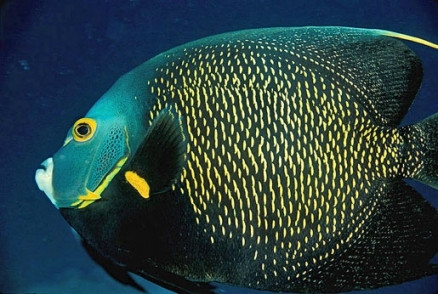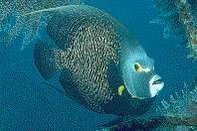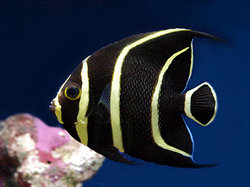French angelfish (Coral Reefs)
Contents
- 1 French angelfish
- 1.1 Introduction The French angelfish (Pomacanthus paru) is a member of the angelfish family (Family Pomacanthidae) that lives among coral reefs (French angelfish) in the Atlantic Ocean. {| style="width: 335px; height: 518px" width="335" border="1" cellspacing="1" cellpadding="1" align="right" |- align="center" | |- align="center" | Scientific Classification Kingdom: Animalia (Animals) Phylum:--- Chordata Class:------ Osteichthyes (Bony Fishes) Order:-------- Perciformes Family:-------- Pomacanthidae (Angelfishes) Genus:----------Pomacanthus Species:----------- Pomacanthus paru (Bloch, 1787) |}
- 1.2 Physical Description
- 1.3 Distribution
- 1.4 Habitat
- 1.5 Feeding Behavior
- 1.6 Behavior
- 1.7 Reproduction
- 1.8 Associations
- 1.9 Conservation Status
- 1.10 References and Further Reading
French angelfish
Introduction The French angelfish (Pomacanthus paru) is a member of the angelfish family (Family Pomacanthidae) that lives among coral reefs (French angelfish) in the Atlantic Ocean. {| style="width: 335px; height: 518px" width="335" border="1" cellspacing="1" cellpadding="1" align="right" |- align="center" | |- align="center" | Scientific Classification Kingdom: Animalia (Animals)
Phylum:--- Chordata
Class:------ Osteichthyes (Bony Fishes)
Order:-------- Perciformes
Family:-------- Pomacanthidae (Angelfishes)
Genus:----------Pomacanthus
Species:----------- Pomacanthus paru (Bloch, 1787) |}
Physical Description
Adult French angelfish range from 25 to 41 centimeters in length. Their laterally compressed, rounded bodies are dark and covered with golden flecks. They also have rounded tails and a yellow ring around the eyes. Juveniles are bright yellow, with yellow bands and a round tail that is black ringed with yellow.
Distribution
This species is abundant along coral reefs along both the Eastern and Western Atlantic. In the Western Atlantic they are found from Florida and the Bahamas to Brazil. In the Eastern Atlantic, they are found along the coastlines of West Africa and around Cape Verde Island.
Habitat
French angelfish are found in coral reef areas in depths of less than forty meters. At night, they seek cover, usually returning to the same location every night. They are often associated with rocky, broken bottoms, coral reefs, and grassy flats, which provide sufficient hiding places and enough protective coverage.
Feeding Behavior
French angelfish feed mainly on sponges (about 70% of their diet) as well as hydroids, tunicates, gorgonians and coral species. Angelfish have adaptations to allow them to feed on sponges. Their strong mouths allow them to tear off pieces of sponges and they secrete mucous around their food to protect their stomachs from the spiny spicules of sponges. Juvenile Gray angelfish may act as cleaners and feed on parasites from other fishes as well as algae.
Behavior
Frenchangelfish feed on the coral reefs throughout the day. They typically travel alone or in pairs. Males form territories to defend their mates from other males.
Reproduction
Reproduction occurs from April to September. They are thought to form monogamous pairs that perhaps form long-term bonds. Spawning occurs at sunset when an egg-filled female travels with the male to the surface where both the eggs (from 25,000 to 75,000 per female) and sperm are released into the water. The eggs hatch in less than a day and the larvaeenter the planktonic stage. When the larvae reach about 15 millimeters they settle on thecoral reef. Maturity is reached after about 3.4 years and they may a lifespan of up to ten years.
Associations
Juvenile French angelfish often act as cleaners.
Conservation Status
French angelfish are considered to be a species at risk.
References and Further Reading
- Pomacanthus paru (Bloch, 1787)
- Pomacanthus paruFrench angelfish
- French Angelfish
- Humann, P. and N. Deloach (Editor), 1994. Reef Fish Identification: Florida, Caribbean, Bahamas. New World Publications, Inc. Jacksonville, FL. ISBN: 1878348078
- Deloach, N. 1999. Reef Fish Behavior, Florida, Caribbean, Bahamas. New World Publications, Inc. Jacksonville, FL. ISBN: 1878348280




0 Comments